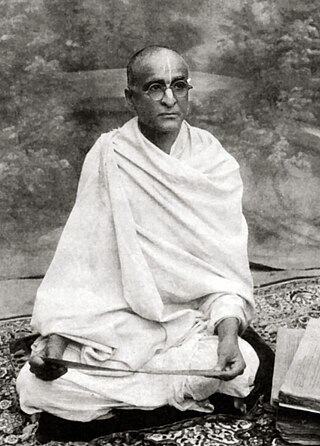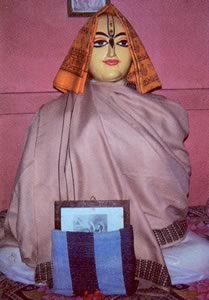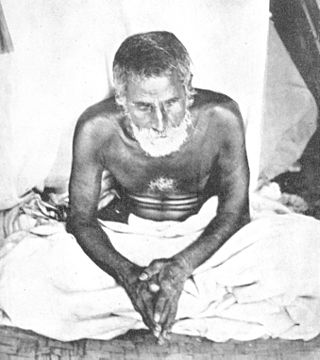
Chaitanya Mahaprabhu, born Vishvambhara Mishra, was an Indian Hindu saint from Bengal and the founder of Gaudiya Vaishnavism. Chaitanya Mahaprabhu's mode of worshipping Krishna with bhajan-kirtan and dance had a profound effect on Vaishnavism in Bengal.

Bhaktisiddhanta Sarasvati, born Bimala Prasad Datt, was an Indian Gaudīya Vaisnava Hindu guru, ācārya, and revivalist in early twentieth-century India. To his followers, he was known as Srila Prabhupāda.

Nityananda, also called Nityananda Prabhu and Nitai, was a primary religious figure within the Gaudiya Vaishnava tradition of Bengal. Nityananda was Chaitanya Mahaprabhu's friend and disciple. Chaitanya and Nityananda are often mentioned together as Gaura-Nitai or Nimai-Nitai.
Narottama Dasa Thakura, also known as Thakura Mahasaya, was a Gaudiya Vaishnava saint who spread Vaishnava bhakti throughout Odisha, in Bengal, and elsewhere in India. Narottama Dasa was the son of King Krishnananda Datta and Narayani Devi, who resided in Gopalpur Pargana of the modern-day Rajshahi district of Bangladesh. According to some scriptues, after the death of his father he entrusted his royal duties to the eldest son of his paternal uncle and left for Vrindavana.

Bhaktivinoda Thakur, born Kedarnath Datta, was an Indian Hindu philosopher, guru and spiritual reformer of Gaudiya Vaishnavism who effected its resurgence in India in late 19th and early 20th century and was called by contemporary scholars as a Gaudiya Vaishnava leader of his time. He, along with his son Bhaktisiddhanta Sarasvati, is also credited with initiating the propagation of Gaudiya Vaishnavism in the West and its global spread.
Baladeva Vidyabhushana also known as Śrī Gauḍīya Vedānta-ācārya Śrīla Baladeva Vidyābhūṣaṇa Prabhupāda was an Indian Gaudiya Vaishnava-Acharya.
Krishnadasa, known by the honorific Kaviraja, was the author of the Chaitanya Charitamrita, a biography on the life of the mystic and saint Chaitanya Mahaprabhu (1486–1533), who is considered by the Gaudiya Vaishnava school of Hinduism to be an incarnation of Radha and Krishna combined.

The Gaudiya Math is a Gaudiya Vaishnava matha formed on 6 September 1920, about 30 months after Bhaktisiddhanta Sarasvati took sannyasa, the renounced order of life. On 7 March 1918, the same day he took sannyasa, he established the Sri Chaitanya Math in Mayapura in West Bengal, later recognised as the parent body of all the Gaudiya Math branches. Its purpose was to spread Gaudiya Vaishnavism, the philosophy of the medieval Vaisnava saint Chaitanya Mahaprabhu, through preaching and publishing.
Swami Sadananda Das was born as Ernst-Georg Schulze in Germany. He met Swami Bhakti Hridaya Bon, a disciple of Hindu spiritual reformer Bhaktisiddhanta Sarasvati Thakura. Sadananda received diksa or formal initiation into the Gaudiya Vaishnava tradition through Swami Bon from Sarasvati, and later received the name Sadananda Das by Sarasvati directly after he had joined the Gaudiya Mission in Calcutta, India. He was one of the first known individuals who was not of Asian origin to embrace the Gaudiya Vaishnava tradition.

Rupa Goswami was a devotional teacher (guru), poet, and philosopher of the Gaudiya Vaishnava tradition. With his brother Sanatana Goswami, he is considered the most senior of the Six Goswamis of Vrindavan associated with Caitanya Mahaprabhu, a hidden avatar (incarnation) of Krishna in Kali Yuga.
Sanatana Goswami was a principal follower of Chaitanya Mahaprabhu. Sanatana wrote a number of works in the bhakti tradition of Gaudiya Vaishnavism and was the senior most of the influential Six Goswamis of Vrindavan, among whom was his brother Rupa Goswami.
Śrī Caitanya-bhāgavata is a hagiography of Caitanya Mahāprabhu written by Vrindavana Dasa Thakura. It was the first full-length work regarding Chaitanya Mahaprabhu written in Bengali language and documents his early life and role as the founder of the Gaudiya Vaishnava tradition. The text details Chaitanya's theological position as a combined Avatar of both Radha and Krishna within the belief of his close associates and followers. The writing of Chaitanya Bhagavata was commissioned by Nityananda, who was the guru of Vrindavana Dasa Thakura and close friend of Chaitanya Mahaprabhu.

Haridasa Thakur was a Vaishnava saint known for playing a part in the initial propagation of Gaudiya Vaishnavism. He is considered to be a known convert of Chaitanya Mahaprabhu, along with Rupa Goswami and Sanatana Goswami. His story of integrity and faith in the face of adversity is told in the Chaitanya Charitamrita. It is believed that Chaitanya Mahaprabhu himself designated Haridasa as nāmācarya, meaning the 'teacher of the Name'. Haridasa Thakura was a devotee of the deity Krishna, and is regarded to have practised the chant of his veneration, the Hare Krishna mantra, 300,000 times daily.
Vaishnava Carana dasa Babaji was a Gaudiya Vaishnava guru. A Vaidya by caste, his birth name was Gokulananda Sen. His sripata was located at Tena Vaidyapura, about six miles from Jhamatpur in modern-day Katwa. He compiled the Padakalpataru in AD 1718–1723. He also wrote the preface for the Mahā-vandanā.
Śrinivāsa Ācārya Ṭhākura was a famous Vaishnava guru, the pupil of Jiva Gosvamin and teacher of Yadunandana dasa and Radhavallabha dasa, among others. He converted King Bir Hambir to Vaishnava. His daughter, Hemalata Thakurani, was also a guru.

An ISKCON guru is a person who is permitted to initiate disciples into the International Society for Krishna Consciousness system. The guru system has undergone several changes and reform since its beginnings in the 1960s. Upanayana as a traditional "sacred thread ceremony" of the Gayatri Mantra, commonly known Hindu Samskara, is complemented by Pancaratric mantras of the Gaudiya Vaishnava sampradaya and follows the principal initial nama initiation ceremony, referred to respectively as brahmana diksa and Hari nama diksa.

Gaurakisora Dasa Babaji is a well-known acharya from the Gaudiya Vaishnava tradition of Hinduism, and is regarded as a Mahatma or saint by followers of his lineage. During his lifetime Gaurakisora Dasa Babaji became famous for his teachings on the process of Bhakti Yoga and for his unorthodox avadhuta like behaviour as a sadhu, or babaji in Vrindavan.
This is a list of works by Bhaktisiddhanta Sarasvati (1874-1937), a Gaudiya Vaishnava leader and religious reformer. This list includes his original works, commentaries on canonical Vaishnava texts, and articles in periodicals Sajjana-toshani and the Gaudiya.
The Gopalas, or Twelve Gopalas, were a group of 16th-century Indian missionaries who are credited with spreading Gaudiya Vaishnavism throughout Bengal. They were major disciples of the Gaudiya-Vaishnava saint Nityananda, who is considered to be an incarnation of Krishna's brother, Balarama.








